Ashton-under-Lyne
| Ashton-under-Lyne | |
| Lancashire | |
|---|---|
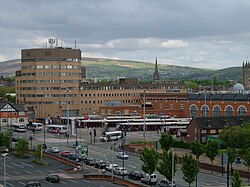 Ashton-under-Lyne town centre | |
| Location | |
| Grid reference: | SJ931997 |
| Location: | 53°29’39"N, 2°6’12"W |
| Data | |
| Population: | 43,236 (2001) |
| Post town: | Ashton-under-Lyne |
| Postcode: | OL6, OL7 |
| Dialling code: | 0161 |
| Local Government | |
| Council: | Tameside |
| Parliamentary constituency: |
Ashton-under-Lyne |
Ashton-under-Lyne is a market town in Lancashire. It stands on the north bank of the River Tame, on undulating land at the foothills of the Pennines. Ashton is 4 miles south of Oldham, 6 miles north of Stockport, and 6 miles east of the City of Manchester.
The town is old; it was important enough to be granted a Royal Charter in 1414. However it only became a major centre at the Industrial Revolution. Until the introduction of the cotton trade in 1769, Ashton was considered "bare, wet, and almost worthless".[1] The factory system, and textile manufacture during the Industrial Revolution triggered a process of unplanned urbanisation in the area, and by the mid-19th century Ashton had emerged as an important mill town at a convergence of newly constructed canals and railways. Ashton-under-Lyne's transport network allowed for an economic boom in cotton spinning, weaving, and coal mining, which led to the granting of borough status in 1847.
Cheap, foreign goods forced Ashton's heavy industries into decline in the latter part of the 20th century, as across much of south Lancashire, but the town has continued to thrive as a centre of commerce. Ashton Market is one of the largest outdoor markets in the United Kingdom. The two-floored Ashton Arcades shopping centre opened in 1995 with 140,000 square feet of trading space. In 2006 IKEA opened what was then the tallest store in the country.
Name
"Ashton" is the Old English æsc tun, meaning "Ash (tree) village".
The origin of the "under-Lyne" suffix is less clear;[2] it possibly derives from the British language lemo meaning elm or may refer to Ashton being "under the line" of the Pennines.[1][2]
History
Evidence of prehistoric activity in the area comes from Ashton Moss – a 264-acre peat bog. A single Mesolithic flint tool has been discovered in the bog,[3][4] along with a collection of nine Neolithic flints.[5] There was further activity in or around the bog in the Bronze Age. In about 1911, an adult male skull was found in the moss; it was thought to belong to the Romano-British period, similar to the Lindow Man bog body, until radiocarbon dating revealed that it dated from 1,320–970 BC.[6][7]
The eastern terminus of the early mediæval linear earthwork Nico Ditch is in Ashton Moss. It dates from the 8th or 9th century. Legend claims it was built in a single night in 869 or 870 as a defence against Viking invaders.[8][9]
An early form of the town's name, which included a burh element, indicates that in the 11th century Ashton-under-Lyne and Bury were two of the most important towns in Lancashire.[10] The "under-Lyne" suffix was not widely used until the mid-19thcentury when it became useful for distinguishing the town from other places called Ashton.
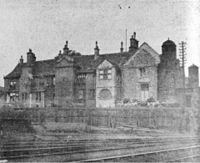
The Domesday Book of 1086 does not directly mention Ashton, perhaps because only a partial survey of the area had been taken.[11][12] However, it is thought that St Michael's Church, mentioned in the entry for the ancient parish of Manchester in the Domesday Survey, was in Ashton. The town itself was first mentioned in the 12th century when the manor was part of the barony of Manchester.[11] By the late 12th century, a family who adopted the name Assheton held the manor on behalf of the Barons of Manchester.[13] Ashton Old Hall was a manor house, the administrative centre of the manor, and the seat of the Assheton family.[14] With three wings, the hall was "one of the finest great houses in the North West" of the 14th century.[14] It has been recognised as important for being one of the few great houses in south-east Lancashire and possibly one of the few halls influenced by French design in the country.[14]
The town was granted a Royal Charter in 1414, which allowed it to hold a fair twice a year, and a market on every Monday,[15][16] making the settlement a market town.[17]
According to popular tradition, Sir Ralph de Assheton, who was Lord of the Manor in the mid-14th century and known as the Black knight, was an unpopular and cruel lord. After his death, his unpopularity led the locals to parade an effigy of him around the town each Easter Monday and collect money.[18] Afterwards the effigy would be hung up, shot, and set on fire, before being torn apart and thrown into the crowd.[19] The first recorded occurrence of the event was in 1795, although the tradition may be older;[20] it continued into the 1830s.[21]
The manor remained in the hands of the Assheton family until 1514 when the line ended; Sir George Booth later acquired the manor and it descended with the Booth family until 1758 when the Earls of Stamford inherited it through marriage. The earls held the manor until the 19th century.[22] The lords' consistent absence was probably the stimulus for Ashton's growth of a large-scale domestic-based textile industry in the 17th century.[23] Pre-industrial Ashton-under-Lyne was centred around four roads: Town Street, Crickets Lane, Old Street, and Cowhill Lane. In the late-18th and early-19th centuries, the town was re-planned, with a grid pattern of roads. As a result, very little remains of the previous town.[17] In 1730 a workhouse was established which consisted of a house and two cottages; it later came to be used as a hospital.[24] The Ashton Canal was constructed in the 1790s to transport coal from the area to Manchester, with a branch to the coal pits at Fairbottom.[25]
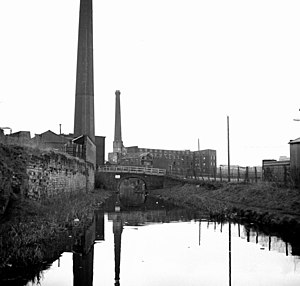
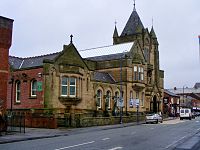
Domestic fustian and woollen weaving have a long history in the town, dating back to at least the Early Modern period. Accounts dated 1626 highlight that Humphrey Chetham had dealings with cloth-makers in Ashton-under-Lyne.[26] However, the introduction of the factory system in the 19th century, during the Industrial Revolution, changed Ashton from a market town to a mill town. Having previously been one of the two main towns in the Tame Valley, Ashton-under-Lyne became one of the "most famous mill towns in the North West".[27] From 1773 to 1905, 75 cotton mills were established in the town. On his tour of Lancashire and Yorkshire in 1849, the publisher Angus Reach said:
In Ashton, too, there lingers on a handful of miserable old men, the remnants of the cotton hand-loom weavers. No young persons think of pursuing such an occupation. The few who practice it were too old and confirmed in old habits, when the power-loom was introduced, to be able to learn a new way of making their bread.[28]—Angus Reach, Morning Chronicle, 1849
The cotton industry in the area grew rapidly from the start of the 19th century until the Lancashire Cotton Famine of 1861–1865.[29] The growth of the town's textile industry led to the construction of estates specifically for workers. Workers' housing in Park Bridge, on the border between Ashton and Oldham, was created in the 1820s.[30] The iron works were founded in 1786 and were some of the earliest in the north west.[31] The Oxford Mills settlement was founded in 1845 by local industrialist and mill-owner Hugh Mason[32] who saw it as a model industrial community. The community was provided with a recreational ground, a gymnasium, and an institute containing public baths, a library, and a reading room.[33] Mason estimated that establishing the settlement cost him around £10,000 and would require a further £1,000 a year to maintain, and that its annual mortality rate was significantly lower than in the rest of the town.[34]
A poor supply of fresh water and dwellings without adequate drainage led to a cholera outbreak in the town in 1832.[35] The Ashton Poor Law Union was established in 1837 and covered Ashton and most of the surrounding area. A new workhouse was built in 1850 which provided housing for 500 people. It later became part of Tameside General Hospital.[24] Construction on the Sheffield, Ashton-under-Lyne and Manchester Railway (SA&MR) began in 1837 to provide passenger transport between Manchester and Sheffield. Although a nine-arch viaduct in Ashton collapsed in April 1845, the line was fully opened on 22 December 1845. The SA&MR was amalgamated with the Sheffield and Lincolnshire Junction Railway, the Great Grimsby & Sheffield Railway, and the Grimsby Docks Company in 1847 to form the Manchester, Sheffield and Lincolnshire Railway (MS&LR).[36] In 1890, the MS&LR bought the Old Hall and demolished it to make way for the construction of new sidings.[14]
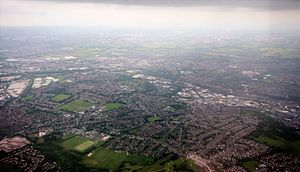
In the late 19th century, public buildings such as the market hall, the town hall, the public library, and public baths were built.[34] A donation from Hugh Mason funded the construction of the baths constructed in 1870–1871.[37] The Ashton-under-Lyne Improvement Act was passed in 1886 which gave the borough influence over housing and allowed the imposition of minimum standards such as drainage.[38] Coal mining not as important to the town as the textile industry, but in 1882 the Ashton Moss Colliery had the deepest mine shaft in the world at 2,854 feet.[34] Ashton's textile industry remained constant between 1865 and the 1920s. Although some mills closed or merged, the number of spindles in use increased.[34] With the collapse of the overseas market in the 1920s, the town's cotton industry went into decline, and by the 1930s most of the firms and mills in the area had closed.[29]
In May 2004, a massive fire ravaged the Victorian market hall, and a temporary building called "The Phoenix Market Hall" was built on Old Cross Street on the opposite side of the old market hall.[39] Described as the "heart of Ashton", the market was rebuilt and officially opened on 1 December 2008.[40]
Churches
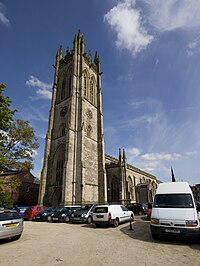
St Michael and All Angels' Church is a Grade I listed building that dates back to at least 1262, although it was rebuilt in the 15th, 16th and 19th centuries.[41] In 1795 it was the only church in the town. There was a great increase in the number of chapels and religious buildings in the area during the 19th century, and by the end of the century there were 44 Anglican churches and 138 chapels belonging to other denominations. The most common denomination amongst the chapels were Congregationalist and Methodist.[42]
The 19th-century evangelist John Wroe attempted to turn Ashton-under-Lyne into a "new Jerusalem". He founded the Christian Israelite Church, and from 1822 to 1831 Ashton-under-Lyne was the religion's headquarters. Wroe intended to build a wall around the town with four gateways, and although the wall was never constructed, the four gatehouses were. Popular opinion in the town turned against Wroe when he was accused of indecent behaviour in 1831, but the charges were dismissed. The Church spread to Australia, where it is still active.[43][44]
The lie of the land
Ashton-under-Lyne stands on the north bank of the River Tame, about 35 feet above the river.[2] Described in Samuel Lewis's A Topographical Dictionary of England (1848) as situated on "on a gentle declivity",[2] Ashton-under-Lyne lies on undulating ground by the Pennines, reaching a maximum elevation of about 1,000 feet above sea level.
The town is 6 miles east of Manchester city centre, and is bound on all sides by other towns: Audenshaw, Droylsden, Dukinfield, Mossley, Oldham and Stalybridge, with little or no green space between them.
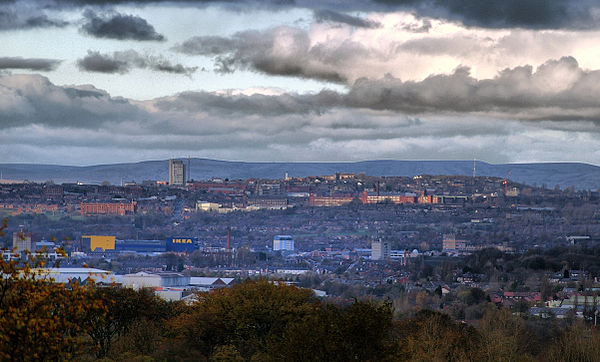
Generally the bedrock of the west of the town consists of coal measures, which were exploited by the coal mining industry, while the east is mainly millstone grit. Overlying the bedrock are deposits of glacial sand and gravel, clay, and some alluvial deposits. Ashton Moss, a peat bog, lies to the west of the town and was originally much larger.[45] The River Tame forms part of the southern boundary, dividing the town from Stalybridge and Dukinfield, and the River Medlock runs to the west. The Peak Forest Canal terminates at Dukinfield Junction on the Ashton Canal, which passes through the town.
Ashton's built environment is similar to the urban structure of most of Lancashire’s, consisting of residential dwellings centred around a market square and high street in the town centre, which is the local centre of commerce. There is a mixture of low-density urban areas, suburbs, semi-rural and rural locations in Ashton-under-Lyne, but overwhelmingly the land use in the town is residential; industrial areas and terraced houses give way to suburbs and rural greenery as the land rises out of the town in the east. The older streets are narrow and irregular, but those built more recently are spacious, lined by "substantial and handsome houses".[2] Areas and suburbs of Ashton-under-Lyne include Ashton Moss, Cockbrook, Hartshead, Hazelhurst, Heys, Hurst, Limehurst, Luzley, Park Bridge, Ryecroft, Taunton, and Waterloo.
Sport
- Cricket: Ashton Cricket Club
- Football
- Ashton United FC
- Curzon Ashton FC
- Athletics:
- East Cheshire Harriers
- Tameside Athletics Club
Sights of the town
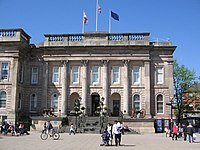
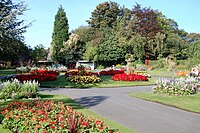
- The Portland Basin warehouse, now a museum, at the point at which the Ashton Canal, the Huddersfield Narrow Canal and the Peak Forest Canal meet.
- Ashton Town Hall, opened in 1840 and enlarged in 1878[46]
- Stamford Park
- Hartshead Pike, a stone tower on top of Hartshead Hill overlooking Ashton and Oldham,[47] built in 1863
- Ashton-under-Lyne War Memorial, in Memorial Gardens
Outside links
| ("Wikimedia Commons" has material about Ashton-under-Lyne) |
References
- ↑ 1.0 1.1 Wilson, Imperial Gazetteer of England (1870–1872).
- ↑ 2.0 2.1 2.2 2.3 2.4 Lewis (1848) pp. 90–96.
- ↑ Nevell (1992), p. 25.
- ↑ Nevell (1992), p. 11.
- ↑ Nevell (1992), p. 30.
- ↑ Nevell (1992), p. 71.
- ↑ Hodgson & Brennand (2004), p. 44.
- ↑ Nevell and Walker (1998), pp. 40–41.
- ↑ Nevell (1992), pp. 77–83.
- ↑ Nevell (1992), p. 88.
- ↑ 11.0 11.1 Nevell (1991), p. 17.
- ↑ Redhead, Norman, in: Hartwell, Hyde and Pevsner (2004), p. 18.
- ↑ Nevell and Walker (1998), p. 47.
- ↑ 14.0 14.1 14.2 14.3 Nevell and Walker (1998), p. 54.
- ↑ Nevell (1991), p. 60.
- ↑ Ashton-under-Lyne town centre, Tameside.gov.uk, http://www.tameside.gov.uk/ashton/towncentre, retrieved 13 September 2008
- ↑ 17.0 17.1 Nevell (1993), p. 146.
- ↑ Griffith (1898), p. 380.
- ↑ Griffith (1898), p. 381.
- ↑ The Black Knight Pageant, Ashton-under-Lyne.com, http://www.ashton-under-lyne.com/traditions/black-knight.htm, retrieved 20 September 2008
- ↑ Griffith (1898), pp. 379, 382.
- ↑ Nevell and Walker (1998), p. 48.
- ↑ McNeil & Nevell (2000), p. 54.
- ↑ 24.0 24.1 Burke and Nevell (1996), p. 123.
- ↑ Nevell (1993), p. 99.
- ↑ Frangopulo (1977), p. 25.
- ↑ McNiel and Nevell (2005), p. 54.
- ↑ Powell (1986), p. 35.
- ↑ 29.0 29.1 Nevell (1993), p. 35.
- ↑ Nevell and Walker (1999), p. 49.
- ↑ Nevell and Roberts (2003), pp. 19, 22, 31–32.
- ↑ Nevell (1993), p. 151.
- ↑ Nevell (1993), p. 152.
- ↑ 34.0 34.1 34.2 34.3 Nevell (1994), pp. 44–45.
- ↑ Nevell (1993), p. 132.
- ↑ Nevell (1993), p. 127.
- ↑ Nevell (1993), p 23.
- ↑ Nevell (1993), pp. 149–151.
- ↑ Sue Carr (21 October 2004), Ashton celebrates as new market opens its doors, Tameside Advertiser, http://www.tamesideadvertiser.co.uk/news/s/385215_ashton_celebrates_as_new_market_opens_its_doors, retrieved 18 September 2008
- ↑ Sue Carr (1 December 2008), Joy as market hall opens, Tameside Advertiser, http://www.tamesideadvertiser.co.uk/news/s/1082748_joy_as_market_hall_opens, retrieved 10 July 2009
- ↑ Nevell (1991), pp. 121, 135.
- ↑ Nevell (1993), p. 142.
- ↑ Nevell (1994), p. 95.
- ↑ A Tribute to Prophet Wroe 1782–1863, Tameside.gov.uk, http://www.tameside.gov.uk/blueplaque/prophetwroe, retrieved 10 July 2009
- ↑ Nevell (1992), pp.10–11.
- ↑ Images of England — details from listed building database (212666) Ashton-under-Lyne Town Hall
- ↑ Wyke (2005), p. 357.
- {{The parish of Ashton-under-Lyne – Introduction, manor & boroughs
- Griffith, Kate (1898), "The Black Lad of Ashton-under-Lyne", Folklore (Folklore Society) 8 (4): 379–382, http://www.archive.org/stream/folklore07britgoog#page/n407/mode/1up
- Hartwell, Clare; Matthew Hyde and Nikolaus Pevsner (2004), Lancashire : Manchester and the South-East, The buildings of England, New Haven, Conn.; London: Yale University Press, ISBN 0-300-10583-5
- Hodgeson, John; Brennand, Mark (2004), Mark Brennand, ed., The Prehistoric Period Resource Assessment, pp. 23–58, SSN 0962-4201
- James, Gary (2008), Manchester – A Football History, Halifax: James Ward, ISBN 978-0-9558127-0-5
- Samuel Lewis (publisher) (1848), A Topographical Dictionary of England, Institute of Historical Research, ISBN 978-0-8063-1508-9, http://www.british-history.ac.uk/report.aspx?compid=50765
- McNeil, R & Nevell, M (2000), A Guide to the Industrial Archaeology of Greater Manchester, Association for Industrial Archaeology, ISBN 0-9528930-3-7
- Nevell, Mike (1991), Tameside 1066–1700, Tameside Metropolitan Borough and University of Manchester Archaeological Unit, ISBN 1-871324-02-5
- Nevell, Mike (1992), Tameside Before 1066, Tameside Metropolitan Borough and Greater Manchester Archaeological Unit, ISBN 1-871324-07-6
- Nevell, Mike (1993), Tameside 1700–1930, Tameside Metropolitan Borough and University of Manchester Archaeological Unit, ISBN 1-871324-08-4
- Nevell, Mike (1994), The People Who Made Tameside, Tameside Metropolitan Borough Council, ISBN 1-871324-12-2
- Nevell, Mike (1997), The Archaeology of Trafford, Trafford Metropolitan Borough Council with the University of Manchester Archaeological Unit, ISBN 1-870695-25-9
- Nevell, Mike; John Roberts (2003), The Park Bridge Ironworks and the archaeology of the Wrought Iron Industry in North West England, 1600 to 1900, Tameside Metropolitan Borough with University of Manchester Archaeological Unit, ISBN 1-871324-27-0
- Nevell, Mike; Walker, John (1998), Lands and Lordships in Tameside, Tameside Metropolitan Borough Council with the University of Manchester Archaeological Unit, ISBN 1-871324-18-1
- Nevell, Mike; Walker, John (2001), Portland Basin and the archaeology of the Canal Warehouse, Tameside Metropolitan Borough with University of Manchester Archaeological Unit, ISBN 1-871324-25-4
- Powell, Rob (1986), In the Wake of King Cotton, Rochdale Art Gallery
- Wilson, John Marius (1870–1872), Imperial Gazetteer of England and Wales, A. Fullarton & Co, http://www.visionofbritain.org.uk/descriptions/entry_page.jsp?text_id=881070&word=NULL
